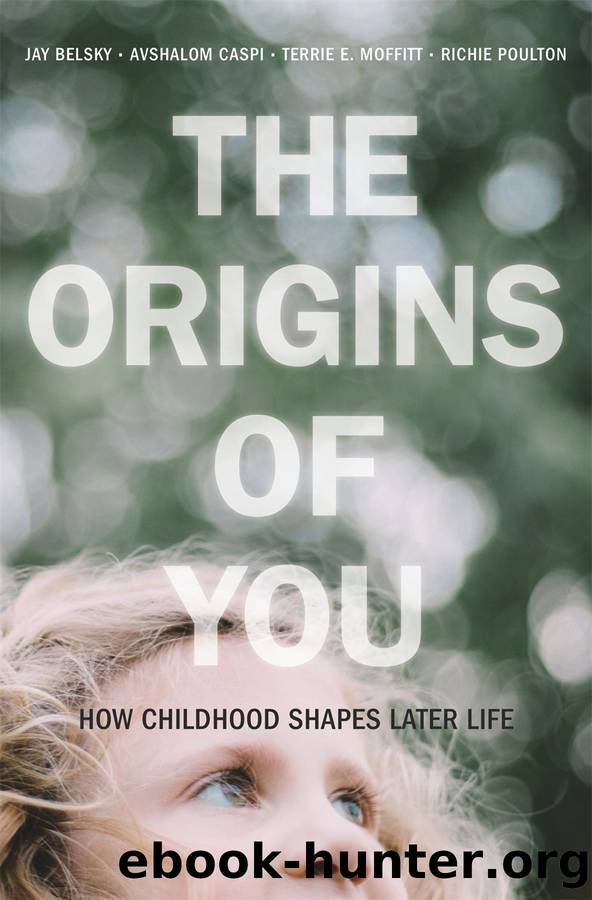The Origins of You by Unknown

Author:Unknown
Language: eng
Format: epub
Publisher: Harvard University Press
EFFECTS OF BULLYING
During the course of our research studying bullying, we carried out three separate investigations of the effects of bullying on bullied children. The first evaluated effects on children’s emotional and behavior problems, the second on self-harm, and the third on being overweight. Each is discussed in turn.
Emotional and Behavior Problems
In order to evaluate effects of bullying on emotional and behavioral problems when children were ten and twelve years of age, we drew on mothers’ and teachers’ reports of children’s behavior. The part of the behavior checklist assessing emotional problems included items such as “cries a lot,” “feels too guilty,” and “worries.” The behavioral problems scale included items pertaining to delinquency (for example, steals) and aggression (for example, “fights a lot”). These behaviors are the same ones mentioned in Chapter 8, dealing with effects of day care, and in Chapter 9, concerned with neighborhoods, because the same measurement tool was used in both the E-Risk Study and the NICHD Study of Early Child Care and Youth Development. To enhance the reliability and thus accuracy of measurement, we once again combined the reports of parents and teachers in our bullying work, just as we had done in our neighborhood research.
As we make clear throughout this book, in nonexperimental, observational research in which children are studied over time and no efforts are made to influence their development, there is always the risk of “reverse causality.” This occurs when some putative “outcome” being measured proves to be related to some suspected source of influence, but it could be because the would-be outcome actually affects the would-be causal factor. Consider the possibility that a sad, inhibited child inadvertently evokes the bullying behavior of others. In this case, the child influences the occurrence of bullying rather than just being affected by it. This is not unusual, as bullies routinely pick on the weak rather than the strong. But just to be clear and not be misunderstood, we do not mean to imply that the bullying experienced is the victim’s fault.
In view of the possibility of reverse causality, we had to appreciate that even if bullying predicted children’s emotional and / or behavioral problems in the future, as we hypothesized would be the case, this could be the result of earlier problem behavior evoking the bullying it would otherwise appear to cause. Therefore, we considered the level of children’s problems before they had a chance to experience bullying in primary school. Only by doing so could we ensure that effects of child behavior eliciting bullying and continuing children’s own future problematic development would not be misconstrued as effects of bullying on children’s adjustment problems. Of course, it is also possible that reciprocal effects characterize the bullying process. This would entail children’s emotional problems inadvertently affecting the bullying treatment they receive and, even after taking this into account, bullying further exacerbating such problems. In other words, causal influence can be bidirectional, going both from child problems to bullying and from bullying to (more) child problems.
As we
Download
This site does not store any files on its server. We only index and link to content provided by other sites. Please contact the content providers to delete copyright contents if any and email us, we'll remove relevant links or contents immediately.
Wonder by R.J. Palacio(7725)
Unlabel: Selling You Without Selling Out by Marc Ecko(2976)
POP by Steven Heller(2880)
Hidden Persuasion: 33 psychological influence techniques in advertising by Marc Andrews & Matthijs van Leeuwen & Rick van Baaren(2772)
The Pixar Touch by David A. Price(2737)
Ogilvy on Advertising by David Ogilvy(2678)
Drawing Cutting Edge Anatomy by Christopher Hart(2672)
Slugfest by Reed Tucker(2413)
The Art of War Visualized by Jessica Hagy(2410)
The Curated Closet by Anuschka Rees(2380)
Stacked Decks by The Rotenberg Collection(2267)
The Wardrobe Wakeup by Lois Joy Johnson(2230)
365 Days of Wonder by R.J. Palacio(2228)
The Code Book by Simon Singh(2205)
Rapid Viz: A New Method for the Rapid Visualization of Ideas by Kurt Hanks & Larry Belliston(2190)
Tell Me More by Kelly Corrigan(2190)
Keep Going by Austin Kleon(2155)
Tattoo Art by Doralba Picerno(2080)
Tokyo Geek's Guide: Manga, Anime, Gaming, Cosplay, Toys, Idols & More - The Ultimate Guide to Japan's Otaku Culture by Simone Gianni(1943)
